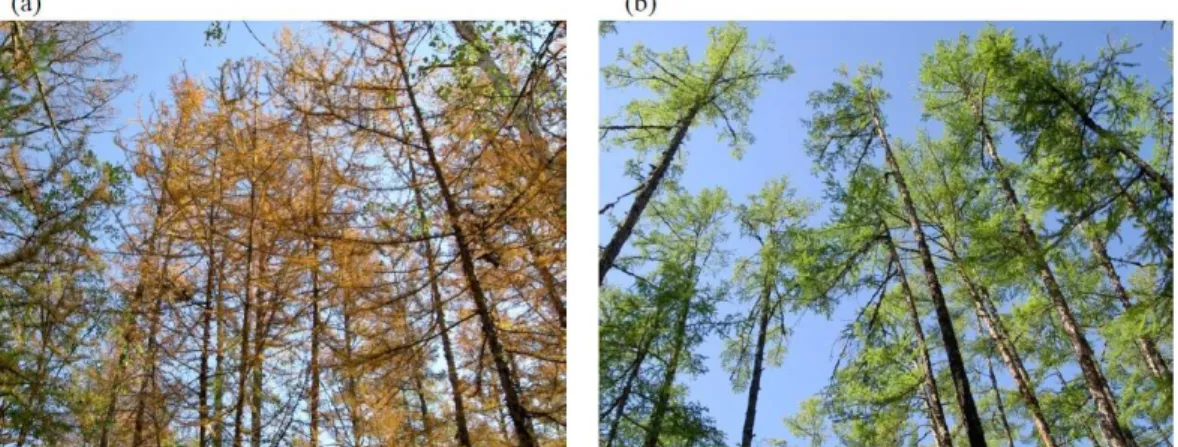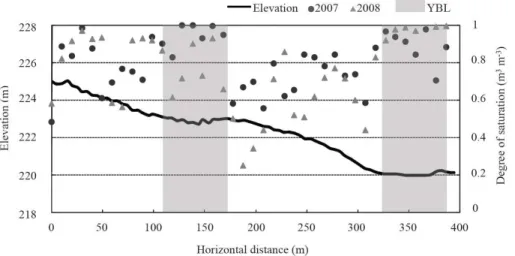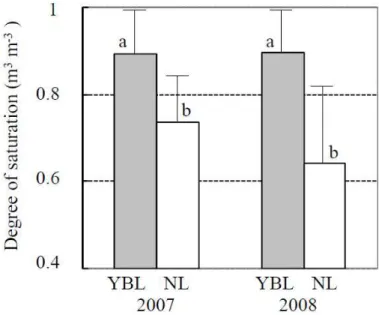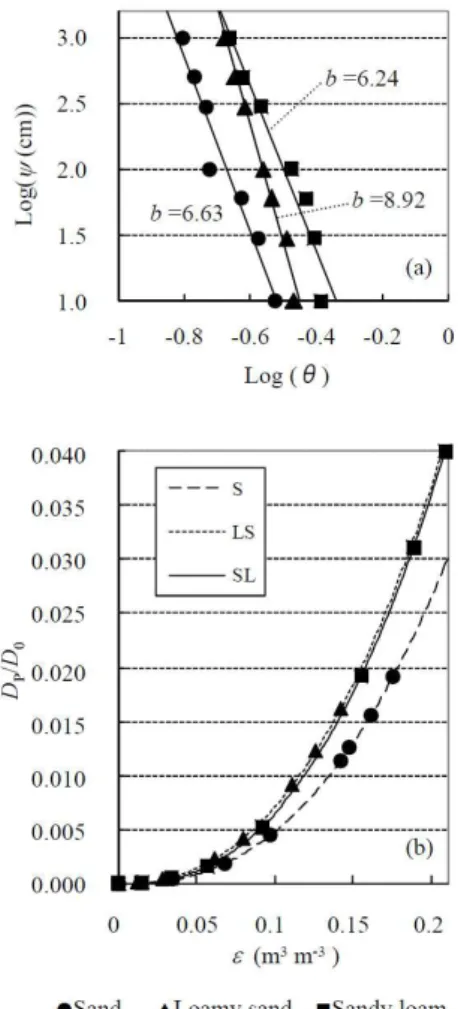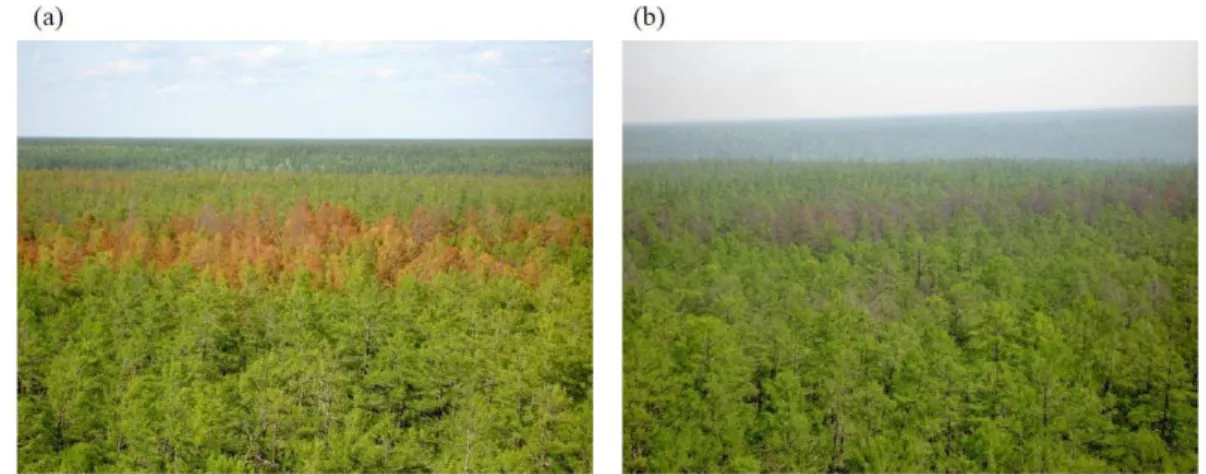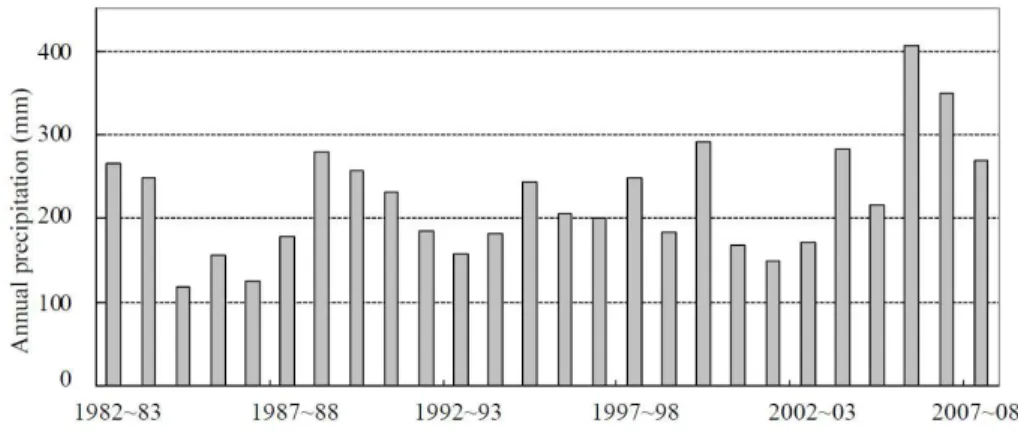HESSD
6, 6087–6105, 2009Forest decline caused by high soil
water conditions
H. Iwasaki et al.
Title Page
Abstract Introduction
Conclusions References
Tables Figures
◭ ◮
◭ ◮
Back Close
Full Screen / Esc
Printer-friendly Version
Interactive Discussion Hydrol. Earth Syst. Sci. Discuss., 6, 6087–6105, 2009
www.hydrol-earth-syst-sci-discuss.net/6/6087/2009/ © Author(s) 2009. This work is distributed under the Creative Commons Attribution 3.0 License.
Hydrology and Earth System Sciences Discussions
Papers published inHydrology and Earth System Sciences Discussionsare under open-access review for the journalHydrology and Earth System Sciences
Forest decline caused by high soil water
conditions in a permafrost region
H. Iwasaki1, H. Saito1, K. Kuwao1, T. C. Maximov2, and S. Hasegawa1
1
Graduate School of Agriculture, Hokkaido University, North 9, West 9, Kita-ku, Sapporo, 060-8589, Japan
2
Institute for Biological Problems of Cryolithozone, Siberian Division of Russian Academy of Sciences, 41, Lenin ave. Yakutsk, 678891, Russia
Received: 28 August 2009 – Accepted: 7 September 2009 – Published: 23 September 2009
Correspondence to: H. Iwasaki (iwasaki@env.agr.hokudai.ac.jp)
HESSD
6, 6087–6105, 2009Forest decline caused by high soil
water conditions
H. Iwasaki et al.
Title Page
Abstract Introduction
Conclusions References
Tables Figures
◭ ◮
◭ ◮
Back Close
Full Screen / Esc
Printer-friendly Version
Interactive Discussion Abstract
In the permafrost region near Yakutsk, eastern Siberia, Russia, annual precipitation (June–May) in 2005–2006 and 2006–2007 exceeded the 26-year (1982–2008) mean of 222±68 mm by 185 mm and 128 mm, respectively, whereas in 2007–2008 the excedent
was only 48 mm, well within the range of variability. Yellowing and browning of larch 5
(Larix cajanderiMayr.) trees occurred in an undisturbed forest near Yakutsk in the 2007 summer growing season. Soil water content at a depth of 0.20 m was measured along a roughly 400 m long line transect running through areas of yellowing and browning larch trees (YBL) and of normal larch trees (NL). In the two years of supranormal precipitation, soil water content was very high compared to values recorded for the 10
same area in previous studies. For both wet years, the mean degree of saturation (s) was significantly greater in YBL than NL areas, whereas the converse was the case for the relative gas diffusivity (DP/D0). This implies that rather than mitigating water stress
suffered during normal precipitation years, elevated soil water conditions adversely affected the growth of larch trees. Eastern Siberia’s taiga forest extends widely into 15
the permafrost region. Was such supranormal annual precipitation to extend for more than two years, as might be expected under impending global climate changes, forest decline would be expanded and a danger of accelerating greenhouse gas emissions could result.
1 Introduction 20
Boreal forest ecosystems occupy 17% of the earth’s terrestrial area and in storing over 30% of terrestrial carbon (Kasischke, 2000) greatly contribute to the global car-bon cycle. Russia’s boreal forests, largely consisting of extensive coniferous or “taiga” forests located in Siberia, cover an expanse of 8.51×106km2, representing about 70%
of the world’s boreal forests (Kasischke, 2000; Food and Agriculture Organization, 25
HESSD
6, 6087–6105, 2009Forest decline caused by high soil
water conditions
H. Iwasaki et al.
Title Page
Abstract Introduction
Conclusions References
Tables Figures
◭ ◮
◭ ◮
Back Close
Full Screen / Esc
Printer-friendly Version
Interactive Discussion (Brown et al., 1997). Recently severe forest disturbances have been reported in Siberia
caused by recent forest fires (Conard et al., 2002; Isaev et al., 2002) and deforestation (Shvidenko and Nilsson, 1996) in Siberia have severely disturbed forest ecosystems. Though occasional naturally-occurring forest fires are important in natural forest re-generation, a remarkable shortening of forest fire intervals has occurred in Siberia in 5
recent years (Takahashi et al., 2002). Furthermore, these forest fires, representing an important source of CO2 which contributes to global warming, may have disturbed much wider expanses of forest than had previously been estimated (Soja et al., 2004). Eastern Siberia’s taiga forest is established on permafrost whose shallow (1–2 m) active layer undergoes seasonal freeze-thaw cycles (Sugimoto et al., 2003). Due to 10
the small amount of precipitation under the region’s continental climate, water stress is a major limiting factor to tree growth. However, in the last three years annual precipita-tion in Yakutsk, eastern Siberia has exceeded the 26-year (1982–2008) mean by 185, 128 and 48 mm. While greater precipitation might have been expected to mitigate larch tree’s water stress, decrease the number of forest fires and thus promote carbon se-15
questration, extensive yellowing and browning of larch trees during the 2007 summer growing season in an undisturbed forest near Yakutsk and their subsequent withering in 2008, led to senescence of the trees, and the emission of CO2 to the atmosphere
through their decomposition (Epron et al., 1999).
Such harmful effects of higher-than-average precipitation have not been reported in 20
HESSD
6, 6087–6105, 2009Forest decline caused by high soil
water conditions
H. Iwasaki et al.
Title Page
Abstract Introduction
Conclusions References
Tables Figures
◭ ◮
◭ ◮
Back Close
Full Screen / Esc
Printer-friendly Version
Interactive Discussion 2 Materials and methods
2.1 Site description
This study was conducted at the Spasskaya Pad experimental forest (62◦15′N,
129◦37′E) of the Institute for Biological Problems of the Cryolithozone, Yakutsk, Re-public of Sakha, Russian Federation. The elevation is roughly 220 m a.s.l. The mean 5
annual temperature and precipitation in this region are−10◦C and 213 mm (Archiborld,
1995), respectively. The forest, dominated by larch (Larix cajanderi Mayr.), with cow-berry (Vaccinium vitis-idaeaL.) in the understory, extends over the gently undulating eastern terrace of the Lena River. Growing at a density of 1000 ha−1 the larch trees
were 13 m tall and 160 years old, on average (Lopez C et al., 2007). Larch roots are 10
shallow and mainly limited to a depth of 0.40 m (Kuwada et al., 2002). The region’s typical Gelisols consists of several layers: an upper litter layer (0.02–0.03 m depth), followed by a humus layer of about 0.10 m, and a mineral layer of sandy to loamy soil beneath. The active layer ranges in depth from 1.0 m to a maximum of 2.0 m. Snow melt ends in early May and soil freezing begins in late September to early October. 15
Larch trees begin to foliate in May and the leaves fall in September. 2.2 Soil sampling and measurement of soil properties
A roughly 400 m line transect across strips of yellowing and browning larch trees (YBL) and remaining normal larch trees (NL) was chosen in 2007 (Fig. 1). Elevation was measured at 5 m intervals along the transect. Undisturbed 100 cm3(20 cm2surface×
20
5.1 cm height) core samples were collected at 10 m intervals in both 2007 (8 August) and 2008 (17 July) from the mineral layer at a depth of 0.20 m. After measuring the mass, core samples were saturated with water by capillarity. Volumetric water content at saturation (θs) and volumetric water content at sampling (θ) were determined by oven drying samples at 105◦C for 24 h.
25
HESSD
6, 6087–6105, 2009Forest decline caused by high soil
water conditions
H. Iwasaki et al.
Title Page
Abstract Introduction
Conclusions References
Tables Figures
◭ ◮
◭ ◮
Back Close
Full Screen / Esc
Printer-friendly Version
Interactive Discussion (LS) or sandy loam (SL). Soil water retention curves (WRCs) were developed for each
soil type using a hanging water column method for matric potentials (ψ) of 0, −10, −30,−60 and−100 cm, and a pressure cell method for ψ values of−300,−500 and −1000 cm.
2.3 Calculations 5
Field soils’ water conditions were evaluated using the degree of saturation (s) and relative gas diffusivity. Values ofsand air-filled porosity (ε) were calculated as follows:
s= θ θs
(1)
ε=θs−θ (2)
Relative gas diffusivity (DP/D0) was calculated following a Soil Water
Characteristic-10
Based Gas Diffusivity Model (Moldrup et al., 1996, Moldrup et al., 2000). DP
D0
=(2ε3100+0.04ε100)
ε
ε100
2+3/b
(3)
where, DP is the gas diffusion coefficient in soil (m2s−1), D0 is the gas diffusion
co-efficient in free air (m2s−1), εis the soil air-filled porosity (m3m−3), ε100 corresponds
air-filled porosity atψ=−100 cm, andbis soil water retention parameter after Campbell
15
(1974). The valuebwas determined as the slope of the WRC in a log-log coordinate plot.
The differences in s andDP/D0 between YBL and NL portions of the transect were
compared by Students’ t-test (1% level) with a modified and approximated t value (Snedecor and Cochran, 1967).
20
HESSD
6, 6087–6105, 2009Forest decline caused by high soil
water conditions
H. Iwasaki et al.
Title Page
Abstract Introduction
Conclusions References
Tables Figures
◭ ◮
◭ ◮
Back Close
Full Screen / Esc
Printer-friendly Version
Interactive Discussion June to the subsequent May precipitation (PJM) data was tabulated for the period of
June 1982 to May 2008.
3 Results and discussion
Horizontal variations in elevation, s, and the strips of yellowing and browning larch trees (YBL) on the line transect are shown in Fig. 2. The line transect had gentle slope 5
(0.5 to 2.0◦) from North to South. Values ofsfluctuated considerably along the transect in both 2007 (0.48 to 1.00), and 2008 (0.24 to 1.00). The YBL regions were located at depressions of the foot slope and showed higher s values. Even though the soil samples were taken at the shallow depth of 0.20 m, several soil samples from YBL were saturated in both years. Soil water content values measured in the present study 10
were high compared to those obtained in previous studies in the same forest. Soil at shallow depths is not normally saturated except in the snowmelt season (Sugimoto et al., 2003; Lopez C et al., 2007; Ohta et al., 2008). Mean s values at YBL and NL areas were 0.89 and 0.73 in 2007, and 0.90 and 0.64 in 2008, respectively (Fig. 3). Meansvalues at YBL sampling points were significantly higher than those at NL points 15
(P <0.01) in both years.
Under high soil water conditions, root respiration is restricted due to poor soil aera-tion, and oxygen supply to plant roots decreases (Bergman, 1959). Relative gas dif-fusivity is often used as a measure to express soil oxygen supply capacity (Grable and Siemer, 1968; Osozawa et al., 1990). Linear relationships were obtained on 20
logarithmically-plotted WRCs for three soil textures (Fig. 4a) and Campbell’s soil wa-ter retention paramewa-ter b was calculated from their slopes. Relative gas diffusivity DP/D0, derived from Eq. (3) usingbvalues drawn from the soils’ air-filled porosity
val-ues (Fig. 4b), shows similar valval-ues for loamy sand (LS) and sandy loam (SL). Mean DP/D0 values at YBL and NL sampling sites were 0.0014 and 0.0075 in 2007, and
25
0.0015 and 0.0146 in 2008, respectively (Fig. 5). In both years meanDP/D0values for
HESSD
6, 6087–6105, 2009Forest decline caused by high soil
water conditions
H. Iwasaki et al.
Title Page
Abstract Introduction
Conclusions References
Tables Figures
◭ ◮
◭ ◮
Back Close
Full Screen / Esc
Printer-friendly Version
Interactive Discussion yearsDP/D0 at YBL was lower than the critical value of DP/D0 for root respiration of
0.005 proposed by Stepniewski (1981). However, Nishimoto (1982) reported that larch trees are particularly susceptible to oxygen deficiency. The lowDP/D0at YBL sampling
sites was tied to their elevated soil water content, which had a destructive effect to larch trees, as exemplified by larch trees in YBL zones in 2007 (Fig. 6a) which did not flush 5
in 2008 (Fig. 6b).
Annual precipitation from June to the subsequent next May (PJM) at Yakutsk over the period of 1982 to 2008 (Fig. 7) shows a mean value ± standard deviation of
222±68 mm. The PJM values for 2005–2006 and 2006–2007 were 407 mm and
350 mm, respectively, or 185 and 128 mm above the 26-year mean, well beyond a 10
standard deviation from the mean. In 2007–2008 the PJM was only 270 mm, 48 mm
higher than normal, but still within a single standard deviation. The lower transect-wide means value in 2008 (0.75) than in 2007 (0.80), are in accord with to the lesserPJM
in 2007–2008 than 2006–2007; however, means values for YBL sampling sites were essentially the same in 2008 (0.89) and 2007 (0.90). This implies that a combination 15
of high precipitation in 2005–2007 and water accumulation in foot slope depressions caused high soil water content conditions at YBL in 2007, and the absence of transpi-ration from dead or damaged trees in YBL zones compounded these high soil water conditions in 2008.
As the frozen layer of the permafrost is largely impermeable (Iwahana et al., 2005), 20
soil water content or soil water stored in the active layer is strongly depended upon the difference between precipitation and evapotranspiration. In normal years, when the forest’s growing season evapotranspiration exceeds precipitation (Ohta et al., 2001), larch trees are subjected to a water deficit. Above average PJM years have occurred
frequently in the last twenty six years, but only in 2005–2006 and 2006–2007 have 25
two consecutive years’PJMexceeded 300 mm (Fig. 7). Since larch trees in YBL zones
began to show leaf yellowing and browning in the 2007 growing season and withered in 2008, the two years’ above normalPJMmust have contributed significantly to the die-off
HESSD
6, 6087–6105, 2009Forest decline caused by high soil
water conditions
H. Iwasaki et al.
Title Page
Abstract Introduction
Conclusions References
Tables Figures
◭ ◮
◭ ◮
Back Close
Full Screen / Esc
Printer-friendly Version
Interactive Discussion 160 years old as mentioned above, therefore the die-offof larch tree is assumed to be
one in at least 160 year event.
Emission of CO2 by forest fires encouraged by dry condition in taiga forests has
at-tracted the attention of global warming investigators (Kasischke and Bruhwiler, 2003). While on the positive side, an increase in precipitation might mitigate water stress of 5
larch trees and decrease the number of forest fires, supranormal precipitation for two consecutive years blighted larch trees. Soil water stored in the active layer should sig-nificantly increase in subsequent years due to the absence of tree transpiration. In the permafrost region of eastern Siberia, when excess permafrost ice thaws after a severe forest disturbance, the surface depressions forms thermokarst, which is termed 10
“alas” in Siberia (Desyatkin, 1993). Abundant melt water from thawing permafrost flows out and makes pond in depression, causing trees to die (Osterkamp et al., 2000; Jor-gensen et al., 2001). Senescence of larch trees due to supranormal precipitation in this study likely occurs through a similar process as that of thermokarsting since both are linked to forest disturbance and both contribute to saturated soil water conditions in the 15
active layer. Forests are generally a sink of greenhouse gases (IPPC, 2001) but can become a source of greenhouse gases upon the senescence of the trees, such as may occur when wet areas are expanded. In addition to CO2 emissions, such decay may
generate CH4emissions (Goulden et al., 1997; Melillo et al., 2003). The present study
demonstrates that taiga forest areas are very sensitive to changes in the precipitation 20
regime.
Global climate change scenarios predict an increase in average global precipitation in the present century and this change will be most pronounced in high latitudes (IPCC, 2001), such as eastern Siberia. Given that eastern Siberia’s taiga forest extends widely over permafrost lands, if supranormal precipitation such as occurred in 2005–2006 and 25
HESSD
6, 6087–6105, 2009Forest decline caused by high soil
water conditions
H. Iwasaki et al.
Title Page
Abstract Introduction
Conclusions References
Tables Figures
◭ ◮
◭ ◮
Back Close
Full Screen / Esc
Printer-friendly Version
Interactive Discussion 4 Conclusions
Soil water conditions in an east Siberian larch forest, which showed growing season yellowing and browning of leaves, were evaluated using degree of saturation, s and predicted relative gas diffusivity, DP/D0. Meansvalues at sampling sites inside zones
of yellowing and browning larch trees (YBL) was significantly higher than in areas with 5
normal growth larch trees (NL). Supranormal precipitation in two consecutive years and the low infiltration capacity of frozen permafrost layer led to high soil water conditions at YBL sites. MeanDP/D0values at YBL sites were significantly lower than those
mea-sured at NL sites. LowDP/D0 at YBL sites caused by an elevated soil water content had a negative effect on larch trees rather than mitigating water stress. These results 10
implied the possibility that climate change could contribute to spreading forest decline, expanding wet areas in the absence of transpiration from larch trees, and CH4
emis-sions under unaerobic soil conditions. The taiga forest ecosystem is, therefore, very susceptible to climate changes and may present a danger of accelerating greenhouse gas emissions.
15
Acknowledgements. This study was funded by Grant-in-Aid for Scientific Research (18255014) of the Japanese Society for the Promotion of Science (JSPS).
References
Archibold, O. W.: Coniferous forest, in: Ecology of world vegetation, Chapman & Hall, London, 238–279, 1995.
20
Bergman, F.: Oxygen deficiency as a cause of disease in plant, Bot. Rev., 25, 417–485, 1959. Brown, J., Ferrians Jr., O. J., Heginbottom, J. A., and Melnikov, E. S.: Circum-Artic map of
permafrost and ground-ice conditions, Circum-Pacific Map Series CP-45, US Geological Survey, 1997.
Campbell, G. S.: A simple method for determining unsaturated conductivity from moisture 25
HESSD
6, 6087–6105, 2009Forest decline caused by high soil
water conditions
H. Iwasaki et al.
Title Page Abstract Introduction Conclusions References Tables Figures ◭ ◮ ◭ ◮ Back Close
Full Screen / Esc
Printer-friendly Version
Interactive Discussion Conard, S. G., Sukhhinin, A. I., Stocks, B. J., Cahoon, D. R., Davidenko, E. P., and Ivanova, G.
A.: Determining effects of area burned and fire severity on carbon cycling and emissions in Siberia, Clim. Change 55, 192–211, 2002.
Desyatkin, R. V.: Syngenetic soil salinization during thermokarst alas formation, Eurasian Soil. Sci., 25, 38–46, 1993.
5
Epron, D., Farque, L., Lucot, E., and Badot, P. M.: Soil CO2 efflux in a beech forest: the contribution of root respiration, Ann. For. Sci., 56, 289–295, 1999.
Food and Agriculture Organization: Global Forest Resources Assessment 2000, Main report, FAO Forestry Paper No. 124, Rome, 2001.
Goulden, M. L. and Crill, P. M.: Automated measurements of CO2exchange at the moss surface 10
of a black spruce forest, Tree Physiol., 17, 537–542, 1997.
Grable, A. R. and Siemer, E. G.: Effects of bulk density, aggregate size, and soil water suction on oxygen diffusion, redox potentials, and elongation of corn roots, Soil Sci. Soc. Proc., 32, 180–186, 1968.
IPPC: Climate Change 2001: The Scientific Basis. Contribution of working group 1 to the third 15
assessment report of the intergovernmental panel on climate change, edited by: Houghton, J. T., Ding, Y., Griggs, D. J., Noguer, M., van der Linden, P. J., Dai, X., Maskell, K., and Johnson, C. A., Cambridge University Press, Cambridge, United Kingdom and New York, NY, USA, 2001.
Isaev, A. S., Korovin, G. N., and Bartalev, S. A.: Using remote sensing to assess Russian forest 20
fire carbon emissions, Clim. Change, 55, 235–249, 2002.
Iwahana, G., Machimura, T., Kobayashi, Y., Fedorov, A. N., Konstantinov, Y., and Fukuda, M.: Influence of forest clear-cutting on the thermal and hydrogical regime of the active layer near Yakutsk, eastern Siberia, J. Geophys. Res., 110, G02004, doi:10.1029/2005JG000039, 2005.
25
Jorgenson, M. T., Racine, C. H., Walters, J. C., and Osterkamp, T. E.: Permafrost degradation and ecological changes associated with a warming climate in Central Alaska, Clim. Change, 48, 551–579, 2001.
Kasischke, E. S.: Boreal ecosystems in the global carbon cycle, in: Fire, Climate Change and Carbon Cycling in the Boreal Forest, edited by: Kasischke, E. S. and Stocks, B. J., Ecological 30
Studies 138, Springer-Verlag, New York, 19–30, 2000.
HESSD
6, 6087–6105, 2009Forest decline caused by high soil
water conditions
H. Iwasaki et al.
Title Page Abstract Introduction Conclusions References Tables Figures ◭ ◮ ◭ ◮ Back Close
Full Screen / Esc
Printer-friendly Version
Interactive Discussion doi:10.1029/2001JD000461, 2003.
Kuwada, T., Kotake, T., Takeuchi, S., Maximov, T. C., and Yoshikawa, K.: Relationships among water dynamics, soil moisture and vapor pressure deflect in a Larix gmelinii stand, eastern boreal Siberia, J. Jpn. For. Soc., 84, 246–254, 2002.
Lopez C, M. L., Saito, H., Kobayashi, Y., Shirota, T., Iwahana, G., Maximov, T. C., and Fukuda, 5
M.: Intreannual environmental-soil thawing rate variation and its control on transpiration from Larix cajanderi, central Yakutia, eastern Siberia, J. Hydrol., 338, 251–260, 2007.
Melillo, J. M., Steudler, P. A., Aber, J. D., Newkirk, K., Lux, H., Bowles, F. P., Catricala, C., Magill, A., Ahrens, T., and Morrisseau, S.: Soil warming and carbon-cycle feedbacks to the climate system, Science, 298, 2173–2176, 2002.
10
Moldrup, P., Kruse, C. W., Rolston, D. E., and Yamaguchi, T.: Modeling diffusion and reaction in soils: V. Predicting gas diffusivity from the Campbell soil-water retension model, Soil Sci., 161, 366–375, 1996.
Moldrup, P., Olesen, T., Schjønning, P., Yamaguchi, T., and Rolston, D. E.: Predicting gas diffusion coefficient in undisturbed soil from soil water characteristics, Soil Sci. Soc. Am. J., 15
64, 94–100, 2000.
Nishimoto, T.: Influence of different soil oxygen-supply capasities and compactness levels on the growth of Larix letolepis GORD. and Picea glehnii MAST. Seedlings, J. Jap. For. Soc., 64, 476–485, 1982.
Ohta, T., Hiyama, T., Tanaka, H., Kuwada, T., Maximov, T. C., Ohata, T., and Fukushima, Y.: 20
Seasonal variation in the energy and water exchanges above and below a larch forest in eastern Siberia, Hydrol. Process., 15, 1459–1476, 2001.
Ohta, T., Maximov, T. C., Dolman, A. J., Nakai, T., van der Molen, M. K., Kononov, A. V., Maximov, A. P., Hiyama, T., Iijima, Y., Moors, E. J., Tanaka, H., Toba, T., and Yabuki, H.: Interannual variation of water balance and summer evapotranspiration in an eastern Siberian 25
larch forest over a 7-year period (1998–2006), Agric. Forest Meteorol., 140, 1941–1953, 2008.
Osozawa, S., Kozai, S., and Kubota, T.: Evaluationg physical condition of kumamoto soil based on the “Non-Limitting Water Range” concept, Soil Phys. Cond. Plant Growth Jpn., 60, 6–14, 1990.
30
HESSD
6, 6087–6105, 2009Forest decline caused by high soil
water conditions
H. Iwasaki et al.
Title Page
Abstract Introduction
Conclusions References
Tables Figures
◭ ◮
◭ ◮
Back Close
Full Screen / Esc
Printer-friendly Version
Interactive Discussion Shvidenko, A. and Nilsson, S.: Expanding forests but declining mature coniferous forests in
Russia, WP-96-59, Intrenational Institute for Applied System Analysis, Laxenburg, 1996. Snedecor, G. W. and Cochran, W. G.: Statistical Methods, 6th Edn., Ames, Iowa State
Univer-sity Press, 1967.
Soja, A. J., Sukhinin, A. I., Cahoon Jr., D. R., Shugart, H. H., and Stackhouse Jr., P. W.: 5
AVHRR-derived fire frequency, distribution and area burned in Siberia, Int. J. Remote Sens., 25, 1939–1960, 2004.
Sugimoto, A., Naito, D., Yanagisawa, N., Ichiyaanagi, K., Kurita, N., Kubota, J., Kotake, T., Ohata, T., Maximov, T. C., and Fedorov, A. N.: Characteristics of soil moisture in permafrost observed in East Siberian taiga with stable isotopes of water, Hydrol. Process., 17, 1073– 10
1092, 2003.
Stepniewski, W.: Oxygen diffusion and strength as related to soil compaction. II. Oxygen diff u-sion coefficient, Pol. J. Soil Sci., 14, 3–13, 1981.
Takahashi, K., Isaev, A. P., Maximov, T. C., and Saito, H.: Fire history of mature larch forests near Yakutsk, eastern Siberia, in: Proceedings of the 10th Symposium on the Joint Siberian 15
HESSD
6, 6087–6105, 2009Forest decline caused by high soil
water conditions
H. Iwasaki et al.
Title Page
Abstract Introduction
Conclusions References
Tables Figures
◭ ◮
◭ ◮
Back Close
Full Screen / Esc
Printer-friendly Version
Interactive Discussion
HESSD
6, 6087–6105, 2009Forest decline caused by high soil
water conditions
H. Iwasaki et al.
Title Page
Abstract Introduction
Conclusions References
Tables Figures
◭ ◮
◭ ◮
Back Close
Full Screen / Esc
Printer-friendly Version
Interactive Discussion
HESSD
6, 6087–6105, 2009Forest decline caused by high soil
water conditions
H. Iwasaki et al.
Title Page
Abstract Introduction
Conclusions References
Tables Figures
◭ ◮
◭ ◮
Back Close
Full Screen / Esc
Printer-friendly Version
Interactive Discussion
HESSD
6, 6087–6105, 2009Forest decline caused by high soil
water conditions
H. Iwasaki et al.
Title Page
Abstract Introduction
Conclusions References
Tables Figures
◭ ◮
◭ ◮
Back Close
Full Screen / Esc
Printer-friendly Version
Interactive Discussion
Fig. 4. (a)WRCs and Campbell (1974) soil water retention parameterbfor each soil texture.
(b) Predicted relative gas diffusivity DP/D0 as a function of air-filled porosity εfor each soil
HESSD
6, 6087–6105, 2009Forest decline caused by high soil
water conditions
H. Iwasaki et al.
Title Page
Abstract Introduction
Conclusions References
Tables Figures
◭ ◮
◭ ◮
Back Close
Full Screen / Esc
Printer-friendly Version
Interactive Discussion
HESSD
6, 6087–6105, 2009Forest decline caused by high soil
water conditions
H. Iwasaki et al.
Title Page
Abstract Introduction
Conclusions References
Tables Figures
◭ ◮
◭ ◮
Back Close
Full Screen / Esc
Printer-friendly Version
Interactive Discussion
HESSD
6, 6087–6105, 2009Forest decline caused by high soil
water conditions
H. Iwasaki et al.
Title Page
Abstract Introduction
Conclusions References
Tables Figures
◭ ◮
◭ ◮
Back Close
Full Screen / Esc
Printer-friendly Version
Interactive Discussion
